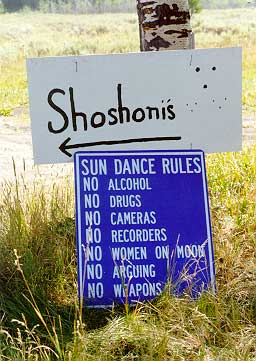The Sacred Journey:
Religions of the World
Core
Discovery Course 166
Section 4
Spring Semester 2011
 |
|
Entrance Sign
Shoshoni Sun Dance, July 2000 source: Frey 2000 |
Welcome to "The Sacred Journey." I'm your instructor, Rodney Frey. My office is in Phinney Hall, Rm. 116, with office hours on Mondays and Wednesdays from 9:30 to noon, and by appointment. You are always welcome in my office. I look forward to visiting with you. You can contact me at:
Voice: 885-6268
E-mail: rfrey@uidaho.edu
My Home Page: www.webpages.uidaho.edu/~rfrey
Our textbooks to be used for Spring semester 2008 are:
- The Qur'an and the Sayings of Prophet Muhammad. Translated by Yusuf Ali. SkyLight Illuminations. 2007
- The Hebrew Prophets, translated by Rabbi Rami Shapiro. SkyLight Illuminations. 2004
- The Gospel of Thomas, translated by Stevan Davies. SkyLight Illuminations. 2002
Class Session days, times, and locations:
Class Days and Times: Tuesday and Thursday from 11:00 to 12:15 am
Classrooms: all classes are in TLC 146
Office Hours:
My office is in Phinney Hall, Rm.116, with office hours on Mondays and Wednesdays 9:30 to 12:00, or by appointment.
Go to:
Schedule of Topics, Assignments and Session Dates - A Map of Our Journey
Course Description - Nature of our Pilgrimage
Leaning Outcomes - Upon Reaching the Summit of Your Pilgrimage
Course Requirements - Skills and Competencies Needed to Reach the Summit
Study Guide for Exams and Pilgrimage Edicts - Assistance Along the Way
Course Resources - More Assistance Along the Way, includes a Bibliography for Projects
Course Description: This course is designed to be a two-semester (fall and spring), learning experience. Our focus will be on the sacred journeys and sacred texts of the world's religious traditions that reveal the great teachings of humanity.
|
|
|
Aswan Mosque, Egypt
|
Throughout history and in the varied societies of the world, sacred journeys have been a fundamental means for providing spiritual and cultural significance and meaning. Sacred journeys go to the heart of what it means to be "human."
Sacred journeys are of many different types and serve a variety of essential roles. In this course we will consider two distinct forms of sacred journeys. There are sacred journeys that are of a personal nature. These journeys include various "rites of passage," such as spiritual quests, initiations into religious orders or statuses, states of illness and healing, and the final rite of passage, death. Sacred journeys can also be of a collective nature. These include groups of people journeying to sacred places, which can be either spatially or temporally oriented. Spatial journeys are illustrated in "pilgrimages" involving travel to a "sacred place," such as to Mecca or Jerusalem or to the Medicine Wheel in the Bighorn Mountains. Temporal journeys are illustrated in the act of storytelling and in certain communal rituals, often referred to as "world renewal ceremonies," in which time is suspended and participants return to "the perennial time of the creation."
While all sacred journeys travel over and through an exterior landscape, seeking to discover the divine in a temple, mosque, synagogue or church, or at a sacred site such as Mecca or Jerusalem, all sacred journeys are fundamentally focused on the interior journeys of the soul and spirit, realizing the divine within oneself. We will discover that all sacred journeys are essential to and shared by all religions throughout time and throughout the world today.
It is through the sacred journeys of the great religions and embedded in their sacred texts that each religion facilitates access to and disseminates their quintessential teachings and truths. Among the sacred texts we will engage are the Bhagavad-Gita, Tao Te Ching, Gospel of Mark, and the Qur'an. For each of the religious traditions we will encounter on our travels this semester, we will explore their great teachings. While there are certainly uniquenesses that distinguish one tradition from the next, we will discover that all the religious traditions have at their core certain essential truths that are shared in common. To frame our quest to learn of these shared truths, we will seek to understand how each religion identifies: 1. the nature of the ultimate divine, 2. the supreme sacred goal and realization in life and death, 3. the means to attaining that goal, the routes to ascendancy, enlightenment, and/or redemption, as well as 4. the sacred landscape upon which one travels to the goal. In addition, this course will address how each religion addresses the nature and role of compassion, forgiveness, and suffering, and the quintessential question, why do bad things happen to good people?
Before we begin our journey and to better equip you for it, we will develop your skill in "eye juggling." Eye juggling is an academic research and learning technique (as distinguished from a theological approach) that allows you to interpret religious symbols, values and stories. As you consider various sacred texts throughout this course, such as an oral narrative or a ritual dance, eye juggling these texts will allow you to better understand the meaning embedded within them. Eye juggling allows you to get a little closer to seeing the world's sacred journeys from the perspectives of the adherents themselves. And as a consequence, by juxtaposing what can be unique and distinct along side what is often veiled and taken for granted, eye juggling also helps you to more clearly reveal and appreciate your own religious values.
While our study of religion will be conducted within a scholarly venue, seeking academic objectives, the sacred journey will not and can not be divorced from your own personal quest. We will learn the value of and attempt to integrate together, both "head" and "heart" knowledge. This course, as with your entire freshmen experience, is itself a special sort of "rite of passage," within which you will receive many powerful "gifts, and journey on your own unique educational pilgrimage in search of your own "special place." Cherish all the "gifts" that are bestowed on you, gifts from your class experiences, as well as outsider the classroom. They will serve you for a life-time.
During the Spring semester the religious traditions we will cover include Judaism, Christianity, and Islam, having covered Primal Religions (Coeur d'Alene and Crow Indian), Hinduism, Buddhism, and Taoism during the Fall semester. In all instances, our focus will be on the contemporary expressions of sacred journeys in the world's religions.
Course Requirements and Grade Distribution: This is a course modeled as a rite of passage and a pilgrimage. As such, it is a course that requires your participation. You can not assume a passive observer's role, viewing the sacred journeys from afar. To help you stay on course and reach your destination, you will need to adhere to the "Pilgrimage Edicts" of this course. You will be expected to complete the following learning activities.
Assessing the Growth of the Neophytes (three exams - 50%)
Personal Quest (individual participatory paper - 20%)
Class Pilgrimages (group presentations, in-class discussions, and reflective writes - 30%)
Grade Distribution: Your final grade will be based upon the total points earned from the participatory paper (5 points for proposal, 5 points for outline and 40 points for paper, for total of 50 points), the exams (90 points; 30 points for each of three exams), and discussion groups, in-class discussion and reflective writes (60 points; 10 points for the discussion group presentation and 2.5 points for the approximate fifteen to twenty writes/discussions). In cases of boarder-line decisions, your class attendance, as well as questions and discussions brought up during class, will be taken into consideration. The following scale will determine your grade: 180-200 (90%-100%) = A, 160-179 (80%-89%) = B, 140-159 (70%-79%) = C, 120-139 (60%-69%) = D
| Study Guide | Resources | Frey's Home Page |
You are currently viewing http://www.webpages.uidaho.edu/~rfrey/166.htm
Page manager: rfrey@uidaho.edu
